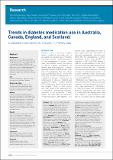Trends in diabetes medication use in Canada, England, Scotland and Australia : a repeated cross-sectional analysis (2012-2017)
Abstract
Background Several new classes of glucose lowering medications have been introduced in the past two decades. Some, such as Sodium-glucose cotransporter 2 inhibitors (SGLT2s), have evidence of improved cardiovascular outcomes, while others, such as Dipeptidyl peptidase-4 inhibitors (DPP4s), do not. It is therefore important to identify their uptake, in order to find ways to support the use of more effective medications. Aims We studied the uptake of these new classes amongst patients with type 2 diabetes. Design and setting Retrospective repeated cross-sectional analysis. We compared rates of medication uptake in Australia, Canada, England and Scotland. Method We used primary care Electronic Medical Data on prescriptions (Canada, UK) and dispensing data (Australia) from 2012 to 2017. We included persons aged 40 years or over on at least one glucose-lowering drug class in each year of interest, excluding those on insulin only. We determined proportions of patients in each nation, for each year, on each class of medication, and on combinations of classes. Results By 2017, data from 238,609 patients were included. The proportion of patients on sulfonylureas (SUs) decreased in three out of four nations, while metformin decreased in Canada. Use of combinations of metformin and new drug classes increased in all nations, replacing combinations involving SUs. In 2017 more patients were on DPP4s (between 19.1% and 27.6%) than on SGLT2s (between 10.1% and 15.3%). Conclusions New drugs are displacing SUs. However, despite evidence of better outcomes, the adoption of SGLT2s lagged behind DPP4s.
Citation
Greiver , M , Havard , A , Kuster Filipe Bowles , J , Kalia , S , Chen , T , Aliarzadeh , B , Moineddin , R , Sherlock , J , Hinton , W , Sullivan , F , O'Neill , B , Pow , C , Bhatt , A , Rahman , F , Meza-Torres , B , Litchfield , M & de Lusignan , S 2021 , ' Trends in diabetes medication use in Canada, England, Scotland and Australia : a repeated cross-sectional analysis (2012-2017) ' , British Journal of General Practice , vol. 71 , no. 704 , pp. e209-e218 . https://doi.org/10.3399/bjgp20X714089
Publication
British Journal of General Practice
Status
Peer reviewed
ISSN
0960-1643Type
Journal article
Description
Funding: This study was supported by Diabetes Action Canada which is funded, in part, through a Canadian Institutes of Health Research chronic disease network grant under the Strategy for Patient-Oriented Research (Funding Reference number: SCA 145101). Dr Greiver is supported through the Gordon F. Cheesbrough Research Chair in Family and Community Medicine from North York General Hospital. Acquisition of the PBS 10% sample data was supported by a NHMRC Centre of Research Excellence Grant (#1060407) and a Cooperative Research Centre Project Grant from the Australian Department of Industry, Innovation and Science (CRC-P-439). AH was supported by a NSW Health Early-Mid Career Fellowship.Collections
Items in the St Andrews Research Repository are protected by copyright, with all rights reserved, unless otherwise indicated.

